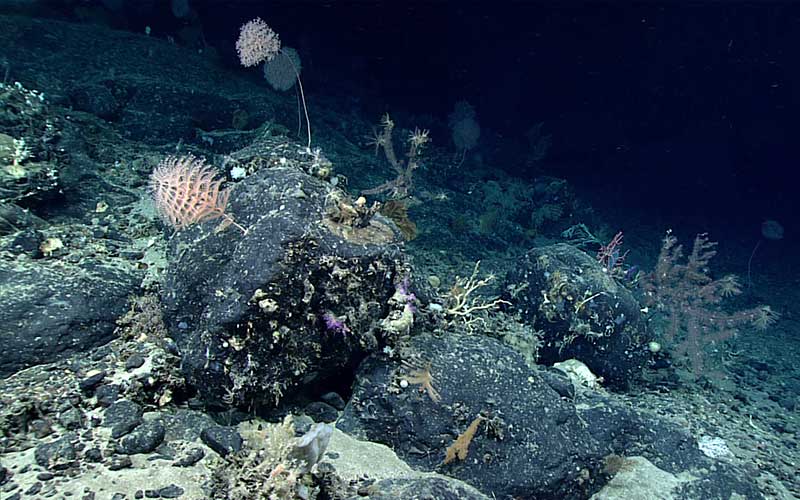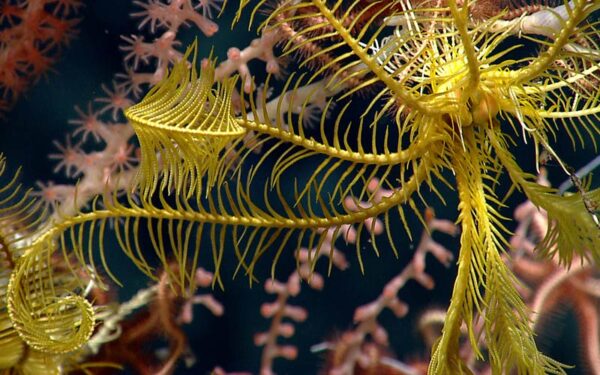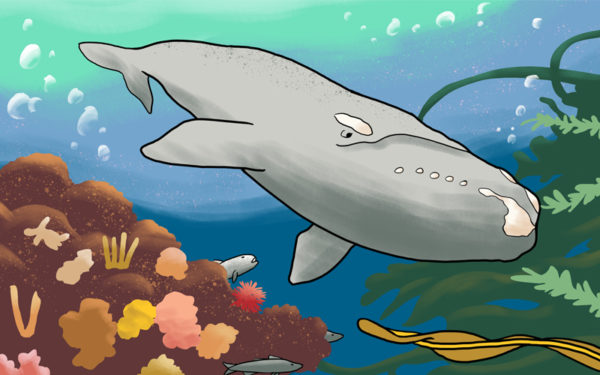
The Northeast Canyons and Seamounts Marine National Monument protects diverse coral populations, among other rare and fragile marine life. Image courtesy of NOAA Ocean Exploration, 2021 North Atlantic Stepping Stones: New England and Corner Rise Seamounts.
From surface to seafloor, the canyons and seamounts off New England’s coast are spectacular. The canyons cut thousands of meters below the sea’s surface, while the seamounts rise like mountains from the ocean floor. Together, they provide a home for all sorts of marine life, from the ancient deep-sea corals that grow in shades of pink and orange to blue whales, the largest animal on earth, that swim at the surface.
The 4,900 square-mile Northeast Canyons and Seamounts Marine National Monument lies some 130 miles off the coast of Cape Cod and includes three canyons and four seamounts. This week, we’re celebrating five years since President Obama designated this unique part of our ocean as the Atlantic’s only marine national monument.
President Biden Must Act to Restore the Canyons and Seamounts’ Full Protections
This fifth anniversary comes at a critical moment. Last year, the Trump administration rolled back the monument’s protections, proclaiming it open to commercial fishing. The president’s illegal action immediately imperiled the fragile habitat and wildlife that call the monument home.
Then in January of this year, on his first day in office, President Biden called for a review of the boundaries and conditions of the Northeast Canyons and Seamounts. As a result, Department of the Interior Secretary Haaland reportedly has recommended fully restoring protections to the Northeast Canyons and Seamounts as well as the Bears Ears and Grand Staircase-Escalante monuments in Utah, which were also rolled back by the Trump administration.
With Climate Change Threatening Global Oceans, We Need More Protected Areas Now
Like all ocean waters worldwide, New England’s ocean is at extraordinary risk due to climate change and the unsustainable human uses of its resources. We’ve known this for years, but recent sobering reports drive home the urgency: Three-quarters of the planet’s lands and two-thirds of its marine environments have been “significantly altered” by human activity. An estimated one million species are threatened with extinction, including about a third of sharks and shark relatives, a third of reef-forming corals, and over a third of marine mammals. Here in New England, the Gulf of Maine is warming faster than 99% of the world’s ocean waters, harming our fisheries like Atlantic cod and our coastal communities that depend on a healthy ocean.
These numbers are frightening, but we can protect the planet, our ocean, and the natural places and wildlife we love if we act now.
A Local Response to a Global Crisis
CLF is part of a growing movement of scientists, policymakers, businesses, and conservation organizations in the United States and worldwide calling for the global protection of at least 30% of land and 30% of the ocean by 2030 (30×30, for short). We must create more areas like our marine national monument where wildlife can recover and thrive without the threat of commercial fishing, oil and gas drilling, and other industrial activities. (We also need more land monuments, like Maine’s Katahdin Woods and Waters National Monument, which is also celebrating its fifth anniversary this year.)
We know that setting aside parts of the ocean leads to healthy marine life. It also fuels an abundance and diversity of life in adjacent waters and builds the ocean’s resilience to climate change. That, in turn, supports our ocean economy, including commercial and recreational fishing and whale watching.
Approximately 23% of our nation’s ocean waters are currently protected, but those protected areas are located almost entirely in the remote Pacific Ocean. In New England, what was once our most strongly protected area – the Northeast Canyons and Seamount Marine National Monument – continues to be at risk because of the Trump administration’s illegal rollback. Other important areas in New England, such as Cashes Ledge and Stellwagen Bank, do not have the level of protection they need and remain at risk from destructive human activities.
A Decade to Act
It’s time to change that. In May, the Biden administration released the Conserving and Restoring America the Beautiful report outlining a wide-ranging conservation vision for our country’s lands and waters. In the report, the administration acknowledges three threats currently facing the planet and people: climate change, the disappearance of nature, and inequitable access to the outdoors. And it calls on federal agencies to support locally-led campaigns to “conserve, connect, and restore the lands, waters, and wildlife upon which we all depend.”
Heeding the scientific advice, CLF wants to see at least 30% of the ocean nationwide be highly to fully protected. That means no or very few extractive or destructive activities will be allowed. Those protections must also be permanent and well-distributed to protect the diverse habitats found throughout the nation’s waters. Restoring protections to the Northeast Canyons and Seamounts is a great place to start.



